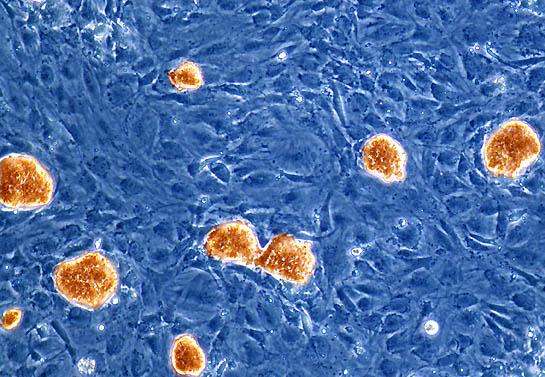A faster, higher-quality way to reprogram cells into stem cells
October 12, 2011

A false-color, microscope view of human induced pluripotent stem cells (orange) growing on "feeder" cells (blue). (Credit: Genome Research Limited)
Wellcome Trust Sanger Institute researchers have announced a new technique to reprogram human cells, such as skin cells, into stem cells.
The researchers said their process increases the efficiency of cell reprogramming 100-fold and generates cells of a higher quality at a faster rate.
Until now, cells have been reprogrammed using four specific regulatory proteins. By adding two further regulatory factors — Retinoic acid receptor gamma (RAR-γ) and liver receptor homolog (Lrh-1) — the researchers said they dramatically improved the efficiency of reprogramming and robustness of stem cell development. The new streamlined process produces cells that can grow more easily.
Quality equivalent to mouse stem cells
“This research is a milestone in human stem cells,” said Sanger Institute researcher Wei Wang. “Our technique provides a foundation to unlock the full potential of stem cells.”
With more than 20 years of research, gold-standard stem cells are derived from mice, largely because they are easy to work with and provide accurate and reproducible results. The team’s aim was to develop human cells of quality equivalent to mouse stem cells.
“The reprogrammed cells developed by our team have proved to have the same capabilities as mouse stem cells,” said Pentao Liu, of the Sanger Institute. “Our approach will enable researchers to easily engineer and reprogram human stem cells to generate cell types for cell replacement therapies in humans.”
The researchers said their technology produced reprogrammed cells after just four days, compared to the seven days required for the four-protein approach.
Ref.: Wang et al., Rapid and efficient reprogramming of somatic cells to induced pluripotent stem cells by retinoic acid receptor gamma and liver receptor homolog, PNAS, 2011; [DOI: 10.1073/pnas.1100893108] (in press)